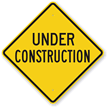The new Bay Bridge is finally here. But is it safe?
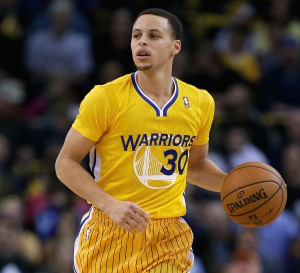
Star point guard for the Golden State Warriors, Stephen Curry, dons the team’s new jersey featuring the signature tower of the new Bay Bridge (via Bleacher Report).
The much maligned and brand-new eastern span of the Bay Bridge is set to open after Labor Day weekend. Even with a number of dangerous flaws discovered in its construction, the new Bay Bridge promises to be much safer than the old one once it opens. With this opening just two weeks away, Bay Area residents seem both extremely impatient and surprised that the thing is actually done.
Unparalleled Bridge, Unparalleled Costs
The brand new eastern section of the bridge is, according to many, one of the most complex bridges in the world. Not only does it employ a gorgeous, 525-foot-tall, self-anchored suspension tower, but the whole bridge can withstand an 8.5 magnitude earthquake. The Loma Prieta quake that brought down a section of the soon-to-be demolished Bay Bridge in 1989 measured a 6.9 on the moment magnitude scale.
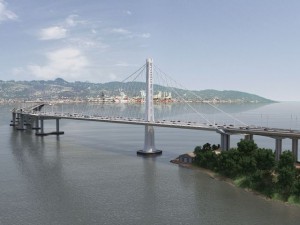
A view of the new Bay Bridge’s eastern span from Treasure island. The signature tower features an asymmetric, self-anchored suspension design (via Telstar Logistics).
To withstand an earthquake almost 51 times stronger than the one that almost destroyed the bridge in 1989, Caltrans and other Bay Bridge builders decided on a flexible design. Such a plan would be much cheaper and more aesthetically pleasing than a rigid design built to resist the violent shaking of an earthquake.
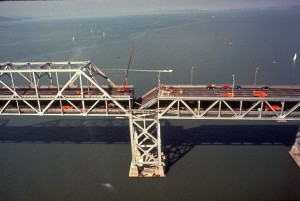
The section of the Bay Bridge that collapsed in the Loma Prieta earthquake of 1989 (via IndyBay).
To achieve this goal, the bridge incorporates metal hinge-pipe beams within the bridge joints. These are designed to bend and even break during an earthquake. This design also incorporates breakable plastics, flexible concrete, and a flexible tower complete with shear links that would absorb the brunt of the seismic shock. To help the bridge move during severe seismic activity, 300-foot battered piles were dug into the bottom of the bay. During an earthquake, its parallel decks would oscillate up and down like a wave while swaying side-to side, and the four legs of the tower and its cable suspension would sway laterally and independently without damaging the tower. Watch this cool video showing how the bridge handles a simulated earthquake.
Although a strong earthquake would damage the shock-absorbing elements of the bridge, the bridge as a whole would remain intact and fully operational. Repairs on these sections would be routine and the bridge could be used 1-2 hours after an earthquake allowing relief resources to move from one side of the bay to the other. This unconventional design makes the new bridge the most advanced bridge in the world.
Unfortunately an astounding bridge design comes with astounding costs. The tower alone adds an estimated cost of over $1 billion to the project’s final price tag of $6.416 billion. Placing the tower at the end of the skyway, near Yerba Buena Island, instead of closer to Oakland, required a much more complex and expensive design. (The U.S. Navy demanded that the tower be closer to its Treasure Island base, which is attached to Yerba Buena.)
The residents of Oakland and the East Bay community demanded that the tower be built in the first place. They believed San Francisco got all the cool stuff like the western span of the Bay Bridge and the Golden Gate, while Oakland would be left with an ugly “highway on stilts.” They are now the ones paying the price –a price that has exceeded its budget by nearly $5.5 billion dollars. At least some say beauty is priceless.
Aside from design expenses, there were political squabbles, a single, monopoly-priced bid, delays, faulty construction, sky-rocketing steel prices, the 911 terrorist attacks, a lack of budget contingency and investigations from multiple government agencies. Almost everything that could go wrong did, which resulted in a final cost that was 493% higher than the original estimation of $1.3 billion in 1997. Given its spiraling costs, the new Bay Bridge had better work.
Is the New Bay Bridge Safe?
Even though the Bay Bridge is set to open in two weeks, it isn’t actually finished…yet. A number of high strength steel bolts holding together crucial pieces of the earthquake shock absorbing system have cracked because of exposure to hydrogen from the seawater below. A full fix of the cracks would postpone the bridge’s opening until 2014. That would make the opening of the bridge 11 years late.
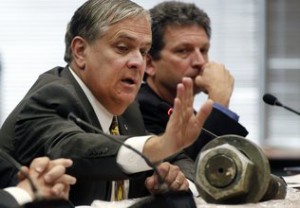
Caltrans officials discuss options going forward with the cracked bolts (via The Sacramento Bee).
Luckily, the Federal Highway Administration accepted a stopgap plan that would allow use of the bridge while a permanent fix for the bolt problem is finished in late December. The long-term fix involves fitting and wrapping the joint elements with a steel saddle that will provide the same structural support and shock-absorbing ability as the original, high-strength bolts. The short-term plan is to fit the vulnerable spots on the bridge with metal plates.
The question then becomes: will the new Bay Bridge be safe to use before the final retrofit is completed in four months? That answer seems to be “yes.” Even though the bridge is not as safe as it will be, experts say it is much safer than the current Bay Bridge.
“The existing bridge is the one folks ought to be worried about, and that’s the one they shouldn’t be trusting,” said Steve Heminger, committee chair and Metropolitan Transportation Commission executive director. “We’ve got two structures out there, side by side, and there is no contest between which one is safer.”
“I want to be on this bridge when the earthquake hits, because it’s going to be a hell of a lot safer than most of the other stuff around, including half of our houses,” he added.
So whether or not the new Bay Bridge will be as safe as it was designed to be years ago, it remains clear that even if it were to open today, it would be much safer than the structure it replaces.
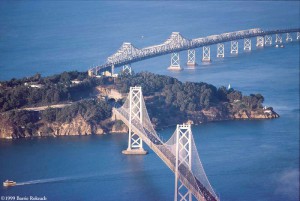
The western span of the Bay Bridge, in the foreground, will remain unchanged visually, but will feature $470 million worth of anti-earthquake retrofitting. The eastern span, in the background, will be demolished. Pieces from its truss design will be recycled (via MetaFiller).
“I have to say that most of the criticism that we have heard lately about this bridge, I would call phantom problems. They’re not real problems. They’re just somebody digging deep enough and finding some irregularity and blowing it out of proportion…I have to say, lately, I think they have probably been overdoing it, in terms of scaring people so much about the integrity of this structure that folks are forgetting that the bridge we ought to be worried about in terms of safety is not the one I’m standing on. It’s the one over there,” Heminger concluded.
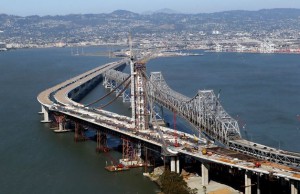
A great and much-prolonged transition. The new Bay Bridge along side the old (via SF Gate).
Category: Construction, Infrastructure














